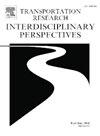Assessing the acceptance and aesthetics of unmanned aerial vehicles (drones): An experimental and survey-based comparison between students and older adults
IF 3.8
Q2 TRANSPORTATION
Transportation Research Interdisciplinary Perspectives
Pub Date : 2025-07-01
DOI:10.1016/j.trip.2025.101497
引用次数: 0
Abstract
Contextual effects and comparisons of technologies to their alternatives (e.g., drones and helicopters) provide the industry, regulators, and other stakeholders with valuable information for more effective participation by communities that are overflown. We present older adults’ (a significant proportion of Western societies) acceptance and beauty ratings of visual stimuli depicting flying quadcopters, replicate and compare these results with those of a previous student study, and overall validate the benefits of experimental approaches for assessing acceptance of Advanced Aerial Mobility (AAM). The stimuli depicted quadcopters with medical or commercial markings, with helicopters and geese used as controls. We tested environmental effects on the ratings by superimposing these objects on urban, industrial, or rural backgrounds and also assessed participants’ knowledge and experience of drones and the reasons for their acceptance ratings.
Only the students’ acceptance ratings were dependent on the environment, the different objects, and the salience of the objects. For older demographic groups, the usage alone may determine acceptance—although not all participants were familiar with the medical usage of AAM. The self-assessed factors behind the acceptance ratings indicated that “usefulness” was the most important factor for both groups, followed by “environment” (which was more important for the older adults). As the simultaneous experimental assessment of different factors’ impact on AAM acceptance yielded valuable information about their importance and the interaction of effects, industries and policymakers should consider the contextual factors and visual effects of AAM, along with other nontechnical variables.
评估无人驾驶飞行器(无人机)的接受度和美学:一项基于实验和调查的学生和老年人的比较
背景效应和技术与其替代方案(如无人机和直升机)的比较为行业、监管机构和其他利益相关者提供了有价值的信息,使被淹没的社区更有效地参与其中。我们展示了老年人(在西方社会中占很大比例)对描绘飞行四轴飞行器的视觉刺激的接受度和美观度评分,并将这些结果与之前的学生研究结果进行了复制和比较,并总体验证了评估先进空中机动(AAM)接受度的实验方法的好处。这些刺激物描绘了带有医疗或商业标志的四轴飞行器,并用直升机和鹅作为控制。我们通过将这些物体叠加在城市、工业或农村背景上,测试了环境对评级的影响,并评估了参与者对无人机的知识和经验,以及他们接受评级的原因。只有学生的接受度取决于环境、不同的物体和物体的显著性。对于年龄较大的人口统计群体,单独使用可能决定接受度-尽管并非所有参与者都熟悉AAM的医疗用途。接受度评分背后的自我评估因素表明,对两组人来说,“有用”是最重要的因素,其次是“环境”(对老年人来说更重要)。由于对不同因素对AAM接受度的影响的同时实验评估产生了有关其重要性和相互作用的有价值的信息,行业和政策制定者应考虑背景因素和AAM的视觉效果,以及其他非技术变量。
本文章由计算机程序翻译,如有差异,请以英文原文为准。
求助全文
约1分钟内获得全文
求助全文
来源期刊

Transportation Research Interdisciplinary Perspectives
Engineering-Automotive Engineering
CiteScore
12.90
自引率
0.00%
发文量
185
审稿时长
22 weeks
 求助内容:
求助内容: 应助结果提醒方式:
应助结果提醒方式:


